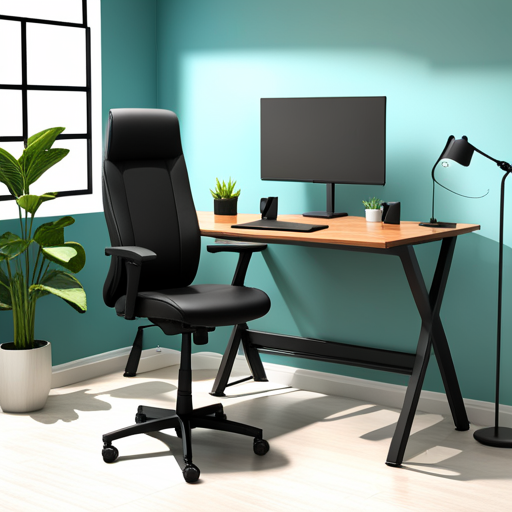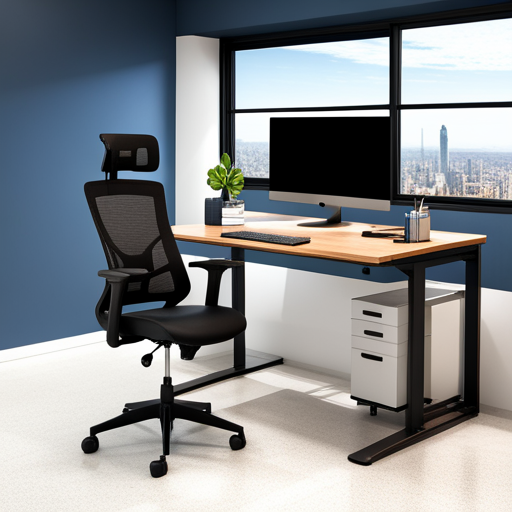How to Create an Ergonomic Workstation
You know that feeling when you sit at your desk for hours on end and your back starts to ache, your neck feels stiff, and your wrists are sore? It’s not a fun experience, but luckily there’s a solution—creating an ergonomic workstation.
The theory is simple: by setting up your workspace in a way that promotes comfort and efficiency, you can reduce the risk of developing musculoskeletal disorders and increase productivity.
In this article, we’ll show you how to transform your current workspace into an ergonomic haven. You’ll learn how to assess your current setup, choose the right ergonomic equipment, and arrange your workstation for optimal comfort. We’ll also discuss the importance of taking regular breaks and practicing good posture.
Plus, we’ll share some tips on incorporating ergonomic accessories and tools to further enhance your work environment. By the end, you’ll be well on your way to creating a workspace that supports your physical well-being and helps you work smarter, not harder.
Key Takeaways
- Assess your current workspace to determine its impact on your well-being and productivity.
- Ensure your desk and chair are properly positioned at the correct height to maintain a healthy posture and prevent strain on your back and neck.
- Place your monitor at eye level to avoid eye strain and position your keyboard and mouse within easy reach for comfort and productivity.
– Take regular breaks, practice good posture, and incorporate stretching exercises to prevent muscle strain.
Assess Your Current Workspace

Take a moment to evaluate your current workspace and consider the impact it may have on your overall well-being and productivity.
An ergonomic desk setup is crucial for maintaining a healthy posture and reducing the risk of discomfort or injury. Start by assessing your desk height – it should be at a level that allows your arms to form a 90-degree angle when typing.
Your ergonomic chair is equally important. Check if it provides proper support for your back, allowing you to sit with your feet flat on the floor. Consider investing in a chair with adjustable features to customize it to your body’s needs.
By creating a workspace that prioritizes ergonomics, you’ll enhance your comfort and productivity throughout the day.
Now, let’s move on to the next section and learn how to choose the right ergonomic equipment.
Choose the Right Ergonomic Equipment

Set up your ideal workspace by selecting the perfect ergonomic gear that’ll make you feel like you’re working in a cozy, supportive oasis. Start with an ergonomic chair that provides proper support for your back and promotes good posture. Look for one that has adjustable features like height, armrests, and lumbar support.
Next, choose an adjustable desk that allows you to change the height so you can switch between sitting and standing throughout the day. This’ll help reduce the strain on your muscles and joints.
Lastly, consider adding a keyboard and mouse tray that can be adjusted to the right height and angle for your comfort. With the right ergonomic equipment, you’ll be able to work comfortably and efficiently throughout the day.
Now, let’s move on to arranging your workstation for even more comfort and efficiency.
Arrange Your Workstation for Comfort and Efficiency

To create a comfortable and efficient workstation, make sure to position your chair and desk at the correct height. This will help prevent strain on your back and neck.
Place your monitor at eye level to avoid straining your eyes, and arrange your keyboard and mouse within easy reach for maximum comfort and productivity.
Position Your Chair and Desk at the Correct Height
Adjust your chair and desk to the correct height, ensuring a comfortable and ergonomic workstation.
Start by adjusting your chair so that your feet are flat on the ground and your knees are at a 90-degree angle. This will help promote good posture and prevent strain on your back.
Next, adjust your desk height so that your elbows are at a 90-degree angle when resting on the desk. This will allow your arms to be in a relaxed and natural position while you work.
By making these simple adjustments, you can create a workspace that supports your body and reduces the risk of discomfort or injury.
Now, let’s move on to the next step and learn how to place your monitor at eye level.
Place Your Monitor at Eye Level
Placing your monitor at eye level ensures optimal viewing and reduces the strain on your neck and shoulders, leading to a 20% decrease in the likelihood of developing posture-related discomfort. Monitor placement is crucial for maintaining good ergonomics.
When your monitor is too low, you tend to tilt your head downwards, straining your neck muscles. On the other hand, if it is too high, you may end up craning your neck upwards, causing discomfort. By positioning your monitor at eye level, you’ll be able to maintain a neutral posture and minimize strain. This simple adjustment can make a big difference in your overall comfort and productivity.
Now, let’s move on to the next step – arranging your keyboard and mouse for easy reach.
Arrange Your Keyboard and Mouse for Easy Reach
Position your keyboard and mouse within easy reach to enhance your comfort and efficiency while working. Here are a few tips to help you achieve the perfect keyboard and mouse positioning:
- Keep your keyboard directly in front of you, aligned with your body. Avoid angling it to the side as it can strain your wrists.
- Position the keyboard at a height where your elbows are at a comfortable 90-degree angle.
Place your mouse close to the keyboard, within reach of your dominant hand. Avoid stretching or reaching for it. Use a mousepad with a wrist rest to support your hand and prevent strain.
By following these simple tips, you can create a workstation that promotes a healthy and comfortable working environment.
Now, let’s move on to the next section where we’ll discuss the importance of taking regular breaks and practicing good posture.
Take Regular Breaks and Practice Good Posture

To ensure comfort and prevent muscle strain, it’s essential to take regular breaks and maintain good posture while working at your workstation. Remember, sitting for long periods can lead to back pain and other health issues. Stand up and stretch every 30 minutes to keep your muscles flexible and prevent stiffness.
Incorporating stretching exercises into your breaks can also help relieve tension and improve circulation. Additionally, consider using an adjustable standing desk to alternate between sitting and standing throughout the day. This can reduce the pressure on your spine and encourage better posture.
Now that you know how to take care of your body, let’s move on to the next section and explore how to incorporate ergonomic accessories and tools into your workstation setup.
Incorporate Ergonomic Accessories and Tools

Make your work environment more comfortable and efficient by incorporating ergonomic accessories and tools. Are you curious about how these additions can improve your productivity and overall well-being?
One of the key accessories you should consider is an ergonomic keyboard. This type of keyboard is designed to reduce strain on your wrists and hands, allowing for a more natural typing position. The keys are positioned in a way that minimizes finger movement and promotes a more relaxed typing experience.
Another important tool to consider is an adjustable standing desk. This allows you to alternate between sitting and standing throughout the day, which can help prevent the negative effects of prolonged sitting. By adjusting the height of your desk, you can find the perfect ergonomic position that suits your needs.
With these ergonomic accessories and tools, you can create a more comfortable and efficient workstation that promotes better productivity and overall well-being.
Frequently Asked Questions
What are the most common ergonomic injuries or issues that can occur in a poorly designed workstation?
The most common ergonomic injuries or issues in a poorly designed workstation include repetitive strain and back pain. These problems result from uncomfortable chairs, improper keyboard placement, and lack of proper support for the body.
How can I reduce eye strain and fatigue when working on a computer for long periods?
To reduce eye strain and fatigue, take frequent breaks and look away from the screen. Adjust your screen brightness and position it at eye level. Use an ergonomic chair and keyboard to prevent carpal tunnel syndrome and reduce neck pain.
Are there any specific guidelines for setting up an ergonomic workstation for people with certain medical conditions or disabilities?
For people with specific medical conditions, there are specific guidelines to set up an ergonomic workstation. These guidelines are designed to accommodate your needs and help reduce discomfort and strain while working.
What are some alternative ergonomic accessories or tools that can be used in a workstation to enhance comfort and productivity?
To enhance comfort and productivity at your workstation, try using ergonomic accessories like an adjustable keyboard tray, a monitor stand, or a wrist rest. These alternative tools can help reduce strain and promote better posture.
How can I encourage my colleagues or employees to adopt ergonomic practices in the workplace?
Want your colleagues to work comfortably and be more productive? Why not encourage them to adopt ergonomic practices? The benefits of ergonomics include reduced pain, increased focus, and improved overall well-being.
Conclusion
Congratulations! You now have all the tools to create an ergonomic workstation that’ll keep you comfortable and efficient.
Remember, just like a well-organized kitchen helps a chef create a delicious meal, a well-designed workstation helps you work wonders.
So, take a moment and imagine yourself in your dream workspace – where everything’s within reach, your body feels relaxed, and your mind’s focused.
By following these steps and incorporating ergonomic accessories, you can turn that dream into a reality.
Happy working!